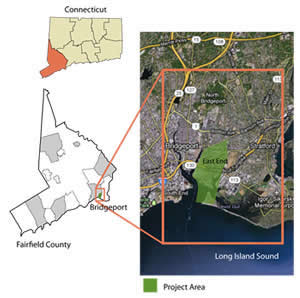Region 1 EJ Showcase Community: Bridgeport, CT
Grants & Programs Topics
EJ Showcase Communities by Region
Overview
EPA Region 1 is building on work that has already taken place to develop community capacity and engagement, identify a broad network of partnerships, and connect with the goals of the city government. Using this past work as a foundation, the Region plans to work collaboratively with a wide-range of stakeholders to develop projects focused on improving indoor air quality, increasing community capacity for green jobs, increasing recycling rates, and reducing asthma and toxic exposure.
Successes
- Removed 600 tons of contaminated soils from an industrial site.
- Leveraged a commitment from the City to invest $1 million dollars to provide low income communities with access to parks along the Bridgeport waterfront.
- Supported the awards of wastewater and drinking water handler certifications to 51 inner city youths.
- Supported stormwater management training for 20 inner city youths and a two-week "Water Boot Camp" for 18 public school students.
- Provided greenscaper training to 28 workers in small and minority landscaping and contracting/construction businesses.
- Other Successes: Region 1 also supported funding awards totaling approximately $16 Million, improved recycling at Bridgeport public schools, supported a hospital pollution prevention workshop attended by 50 persons, supported in home asthma training, contributed to the cleanup of the Bridgeport waterfront, and participated in the Pequonnock River Initiative.
History

EPA Region 1, together with state, county, city, non-profit, and community organizations, is working with several communities in Bridgeport on a series of environmental justice issues affecting human health and the ambient environment. The Project was designed to expand collaboration among a range of diverse stakeholders in order to solve some substantial environmental issues. Region I has programs designed to improve indoor air quality, encourage green jobs in the community, increase recycling rates, and reduce asthma and toxic exposure in schools and homes. The region awarded $100,000 to support the programming. The Region awarded $25,000 to the Bridgeport Board of Education and the City of Bridgeport to pilot a paper recycling program at two local schools. The Connecticut Coalition for Environmental Justice , a community based organization, will coordinate a community fair focused on asthma, bringing together city organizations working on asthma and healthy homes to effectively share resources.
Green jobs and youth development have been critical program elements. To attract young people into water industry careers, EPA New England worked with the Connecticut Section of the American Water Works Association, the Water and People Program, and the public schools to establish a Water Boot Camp. These groups are leading the way in connecting with youth to teach them about water resources and prepare them for green jobs in water operations. Groundwork Bridgeport will train and develop 20 Bridgeport youth water resource protection advocates, mark 600 street drains indicating that they drain into Long Island Sound and must be kept clean, and organize four neighborhood meetings for residents and local businesses about how they can protect water resources. The City’s Workplace, Inc. jobs training program is devising training for inner city youth to receive waste water and drinking water handler certifications. Beyond the water projects, the region facilitated Greenscaper Training at Bridgeport’s Beardsley Zoo. The training focused on vegetated rain gardens as a way to control stormwater runoff.
The Region has worked with the Port Authority to make them aware of basic compliance and sustainability issues, including requirements for large ocean-going ships visiting or passing by Bridgeport within 200 nautical miles of shore having to burn lower-sulfur fuel. At the request of some community groups and the City, EPA funded a removal at the Chrome Engineering site. EPA disposed of contaminated soil using innovations that render contaminated soils non-hazardous. The Agency is also participating in the Pequonnock River Initiative, a partnership between the City of Bridgeport and the towns of Monroe and Trumbull to develop a watershed plan for the Pequonnock River watershed. The Region has also sought to leverage resources to restore portions of Johnson’s Creek and Pleasure Beach. Fish and Wildlife has been a participant along with a number of nongovernmental organizations.
Finally, the Region has learned that more training is essential. The Region will provide an overview of environmental laws, compliance assistance, land use planning and restoration, and climate change awareness training. Much of this work will be done with the support of the stakeholders and through a $25,000 grant from EPA to the Rhode Island Legal Services. The firm will develop the New England Environmental Justice Forum and organize up to three trainings for EJ groups and their advocates.
Bridgeport was awarded one of its largest federal grants ever, an $11 million TIGER grant, or Transportation Investment Generating Economic Recovery. This grant will help prepare the harbor-side of Steel Pointe for development by funding infrastructure improvements, and will be matched by an $18 million contribution by developer Bridgeport Landing LLC.
Bridgeport also received part of a $3.5 million Sustainable Communities grant, which will pay for a feasibility study into a potential new train station on the East Side and benefit the New York City to New Haven corridor.
For more information or to become involved, please contact Deborah Brown (brown.deborah@epa.gov), EPA New England, at 617-918-1706.
![[logo] US EPA](../gif/logo_epaseal.gif)